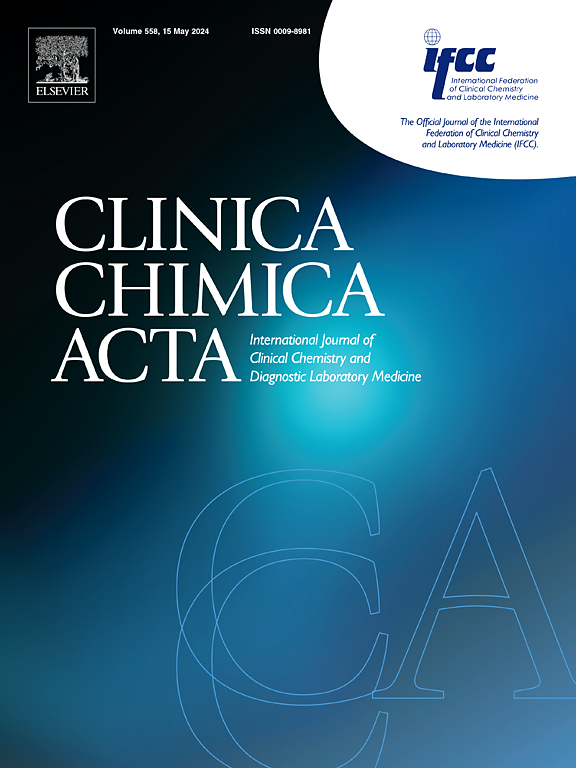proonephro AKI™检测在儿科患者中的性能和稳定性的多中心评估
IF 2.9
3区 医学
Q2 MEDICAL LABORATORY TECHNOLOGY
引用次数: 0
摘要
急性肾损伤(AKI),定义为血清肌酐升高或尿量减少,在危重儿科患者中非常普遍。由于不准确和反应延迟,依靠这些诊断AKI是不可靠的。中性粒细胞明胶酶相关脂钙蛋白(NGAL)是早期AKI检测的有希望的生物标志物。本研究调查了一种新的自动尿液NGAL测试在儿科患者中的分析性能。材料和方法在Roche cobas®c501分析仪上使用proonephroaki™颗粒增强浊度免疫分析法测量儿科患者尿液NGAL。评估检测的灵敏度、特异性和线性。在三个实验室使用7个儿童尿液样本研究了测试的可重复性。在室温、冷藏和冷冻后,对16份儿童天然尿液样本进行了尿液NGAL的稳定性评估。结果测定的空白限(LoB)、检测限(LoD)和定量限(LoQ)分别为9、14和18 ng/mL。在50-3000 ng/mL范围内证实线性。按照CLSI EP5-03指南进行的精密度研究显示,重复性、批间、日间和总精密度的变异系数(cv)分别为≤5.0 %、≤3.1 %、≤1.7 %和≤4.9 %。三个实验室的重复性≤6.6 %。特异性试验显示,高比重、15种内源性物质、3种造影剂、pH变化(3.3-10.3)或33种药物化合物(除非常高浓度的头孢吡肟和头孢曲松外)没有显著干扰。10个潜在的交叉反应性生物标志物未观察到交叉反应性。用16例患者的尿液样本测试了尿液中NGAL的稳定性,结果显示在环境温度下稳定2 天,冷藏4 天,冷冻13 个月(−70 °C或以下),以及3个冷冻/解冻循环。结论proonephroaki™检测方法具有良好的精密度、重复性、敏感性、特异性和稳定性,满足临床诊断和治疗危重儿科患者AKI所需的分析性能。本文章由计算机程序翻译,如有差异,请以英文原文为准。
Multicenter evaluation of the ProNephro AKI™ assay performance and stability in pediatric patients
Introduction
Acute Kidney Injury (AKI), defined by increased serum creatinine or decreased urine volume, is highly prevalent in critically ill pediatric patients. Reliance on these for AKI diagnosis is unreliable due to inaccuracy and delayed response. Neutrophil Gelatinase-Associated Lipocalin (NGAL) is a promising biomarker for early AKI detection. This study investigated the analytical performance of a new automated urine NGAL test in pediatric patients.
Materials and methods
The ProNephroAKI™ particle-enhanced turbidimetric immunoassay was run on the Roche cobas® c501 analyzer to measure urine NGAL in pediatric patients. The test sensitivity, specificity, and linearity were evaluated. The test reproducibility was studied in three laboratories using seven pediatric urine samples. The stability of urine NGAL was assessed in sixteen native urine pediatric samples after storage at room temperature, refrigerated, and frozen.
Results
The limits of blank (LoB), detection (LoD), and quantitation (LoQ) were determined as 9, 14, and 18 ng/mL, respectively. Linearity was confirmed across the range of 50–3000 ng/mL. Precision studies following CLSI EP5-03 guidelines showed coefficients of variation (CVs) for repeatability, between-run, between-day, and total precision at ≤5.0 %, ≤3.1 %, ≤1.7 %, and ≤4.9 %, respectively. Reproducibility across three laboratories was ≤6.6 %. Specificity tests showed no significant interference from high specific gravity, 15 endogenous substances, 3 contrast agents, pH variations (3.3–10.3), or 33 pharmaceutical compounds, except very high concentrations of cefepime and ceftriaxone. Cross-reactivity was not observed from 10 potential cross-reactive biomarkers. NGAL stability in urine was tested with samples from 16 patients, demonstrating stability for 2 days at ambient temperature, 4 days refrigerated, 13 months frozen (−70 °C or below), and 3 freeze/thaw cycles.
Conclusions
The ProNephroAKI™ assay shows excellent precision, reproducibility, sensitivity, specificity, and stability, meeting the required analytical performance for clinical use in diagnosing and managing AKI in critically ill pediatric patients.
求助全文
通过发布文献求助,成功后即可免费获取论文全文。
去求助
来源期刊

Clinica Chimica Acta
医学-医学实验技术
CiteScore
10.10
自引率
2.00%
发文量
1268
审稿时长
23 days
期刊介绍:
The Official Journal of the International Federation of Clinical Chemistry and Laboratory Medicine (IFCC)
Clinica Chimica Acta is a high-quality journal which publishes original Research Communications in the field of clinical chemistry and laboratory medicine, defined as the diagnostic application of chemistry, biochemistry, immunochemistry, biochemical aspects of hematology, toxicology, and molecular biology to the study of human disease in body fluids and cells.
The objective of the journal is to publish novel information leading to a better understanding of biological mechanisms of human diseases, their prevention, diagnosis, and patient management. Reports of an applied clinical character are also welcome. Papers concerned with normal metabolic processes or with constituents of normal cells or body fluids, such as reports of experimental or clinical studies in animals, are only considered when they are clearly and directly relevant to human disease. Evaluation of commercial products have a low priority for publication, unless they are novel or represent a technological breakthrough. Studies dealing with effects of drugs and natural products and studies dealing with the redox status in various diseases are not within the journal''s scope. Development and evaluation of novel analytical methodologies where applicable to diagnostic clinical chemistry and laboratory medicine, including point-of-care testing, and topics on laboratory management and informatics will also be considered. Studies focused on emerging diagnostic technologies and (big) data analysis procedures including digitalization, mobile Health, and artificial Intelligence applied to Laboratory Medicine are also of interest.
 求助内容:
求助内容: 应助结果提醒方式:
应助结果提醒方式:


